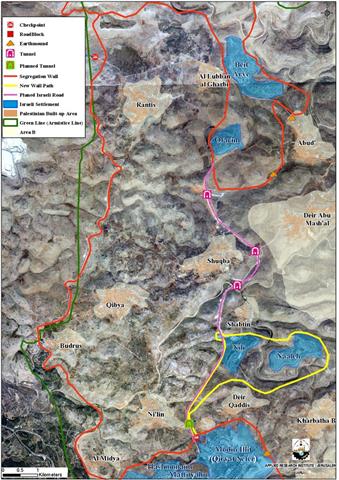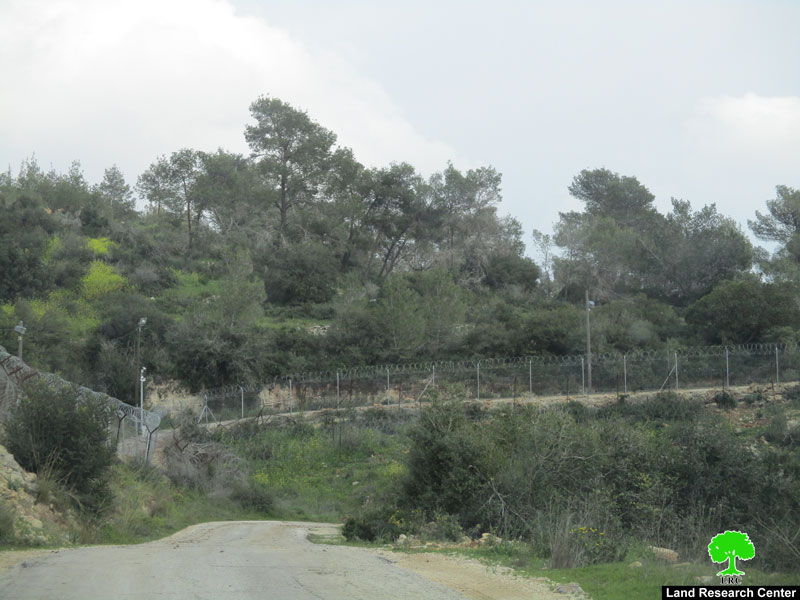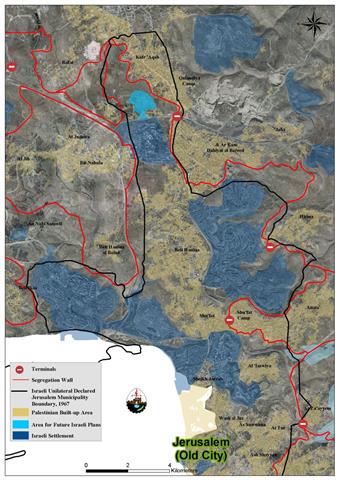On February 1, 2007, the Israeli Prime Minister Ehud Olmert, has approved a plan to reroute a section of the Segregation Wall to increase its length by 12 Km. the newly added section is set to take place north of the Modi'in Illit settlements block west of Ramallah governorate, about five Km from the 1949 Armistice Line (the Green Line). The recently approved addition Wall length, aim to encompass two Israeli settlements within the Segregation Wall, Nili (Est. 1981, pop. 879) and Na'leh (Est. 1988, pop. 637).
Olmert decision came after an exerted pressure from the Israeli settlers of the two settlements (Nili & Na'leh), when the settlements were left outside the Segregation Wall, according to the Segregation Wall route approved by the Israeli government on April 30, 2006. See Map of the new Wall route
A Dangerous Escalation
The new route will create a Palestinian enclave, isolating seven Palestinian villages of (Al Luban Al Gharbi- Rantis- Shuqba – Qibya- Budrus- Ni'lin – Al Midya) with a total population of 21,235Palestinian residents. See table 1
Table 1: table of the data about the seven Palestinian villages inside the enclave
|
Village Name |
Population (2006 PCBS) |
|
Al Luban Al Gharbi |
1510 |
|
Rantis |
2893 |
|
Shuqba |
4335 |
|
Qibya |
4929 |
|
Budrus |
1512 |
|
Ni'lin |
4751 |
|
Al Midya |
1305 |
|
Total |
21,235 |
Source: ARIJ GIS-Database 2006
The newly added 12 Km section to the Segregation Wall comes to reinforce the enclave surrounding the seven Palestinian localities, which was bounded by an Israeli controlled road, used only by the Israeli Army and settlers. The road that holds the number 446, stretch down from the north of the enclave near Ofarim settlement and heads southward to Qiryat Sefer settlement. Four tunnels are constructed underneath the road, three of which are functional already, while the remaining one to be completed by the end of 2007. The tunnels will be controlled by the Israeli Army and will be used for Palestinians in the enclave to travel to the West Bank.
According to the Segregation Wall, plan of April 30, 2006, the two settlements in question (Nili & Na'leh) were set to be surrounded with double fence but not actually included within the Segregation Wall, at least to the time when the new amendments approved in February 2007.
It is not unprecedented that the Israelis have adjusted the route of the Segregation Wall tactfully to include more lands or several settlements, both of which was the case in the approved section of the Wall.
To Conclude
The Israeli pretext for the so-called Security fence is no longer viable as they admitted clearly and bluntly that the Segregation Wall might constitute the future border of the Israeli State, a fact that they will make reality of, once they completed the construction process of it. More than that, the Israeli Segregation Wall aimed to secure much of the Israeli settlements blocs and the majority of its Israeli settlers within the Segregation Wall. 103 out of 207 settlements with 85% of the settler' population (408,000) are included west of the segregation Wall an area Israel plans to keep under any peace settlement as they repeatedly claimed. It becomes clear that the Israeli decision to build the Segregation Wall in the Palestinian Territory is a step to set the undeclared Israeli borders with as many settlements, but it was not at any time a mean to achieve peace and security to the Israeli people.
In spite the international condemnation, to the Israeli decision to built the Segregation Wall in the year 2002, and the International Courte of Justice (ICJ) ruling of July 9, 2004, which condemned the construction of the Segregation Wall and all Israeli related activities, Israel still insist to violate the worlds well and continue with its settlements program and the Segregation Wall.
Finally, the construction of the Israeli Segregation Wall in the occupied Palestinian territory clearly violates and contradicts many of the International Humanitarian law rules, specifically The Hague Regulations of 1907 and the Fourth Geneva Convention of 1949, which state the following:
-
The Hague Regulations expressly forbids an occupying power 'to destroy or seize the enemy's property, unless such destruction or seizure be imperatively demanded by the necessities of war' (Article 23).
-
The Fourth Geneva Convention, the primary document of international law governing instances of military occupation, states in Article 49 that: 'The occupying power shall not deport or transfer parts of its own population into the territories it occupies.'
-
Article 53 of the Fourth Geneva Convention is also clear that: 'any destruction by the Occupying Power of real or personal property belonging individually or collectively to private persons, or to the State, or to other public authorities, or to social or cooperative organizations, is prohibited, except where such destruction is rendered absolutely necessary by military operations.'
-
The appropriation and destruction of Palestinian land is an especially serious violation of the Fourth Geneva Convention, Article 147 of which clearly prohibits,''extensive destruction and appropriation of property, not justified by military necessity and carried out unlawfully and wantonly.'' Violations of Articles of the Fourth Geneva Convention constitute grave breaches of the Convention and should be prosecuted as War Crimes.
Prepared by
The Applied Research Institute – Jerusalem
ARIJ












